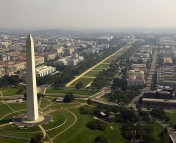Once again, Astrobites is liveblogging AAS! In order to avoid inundating our readers’ RSS feeds, we’ll be updating this post with short paragraphs about the talks we’ve heard and posters we’ve seen. Keep checking back throughout Wednesday morning!
The Milky Way Stellar Graveyard – Jason Kalirai
How much mass do stars lose? This is an important question because stars’ mass loss strongly affects their later evolution (and is an interesting question in and of itself). But there are a lot of factors that affect mass loss, making it difficult to approach theoretically. Kalirai’s work tries to constrain stellar mass loss observationally. It’s hard though, because we can’t just watch a star over its life time and see how much mass it loses. Kalirai’s work exploits star clusters as a way of simultaneously measuring the initial mass of a star and the final mass of the white dwarf. Here’s the idea: the main sequence turn off is the mass where stars have evolved off the main sequence. It’s these stars that form the brightest, youngest white dwarfs in the cluster (this works because stars move very rapidly from main sequence to white dwarf). If you observe both the main sequence turnoff and the white dwarfs in the cluster, and you can figure out the masses of both, then you’ve done it! In this way, Kalirai and his collaborators are able to simultaneously constrain the initial masses of stars that form white dwarfs, and the final masses of those white dwarfs. They do this for multiple star clusters and because clusters of different ages have different turn off masses, they are able to probe different masses.
References to some of the papers mentioned:
http://adsabs.harvard.edu/abs/2008ApJ…676..594K
http://adsabs.harvard.edu/abs/2013arXiv1312.4544K
http://adsabs.harvard.edu/abs/2012Natur.486…90K
http://adsabs.harvard.edu/abs/2012AJ….143…11K
Wednesday, 8 January, 10:15 am EST
Care & Feeding of Black Holes
Giant Black Holes Found in Dwarf Galaxies
Amy Reines (National Radio Astronomy Observatory)
[129.04]
We’ve had evidence for a while that there are super-massive black holes in the centers of all full-sized galaxies, but what about dwarf galaxies? Measurements of the Large Magellanic Cloud (which is a dwarf galaxy) seem to indicate that there’s no massive black hole in the center, and in fact, up until recently we’d never detected evidence of massive black holes in the center of ANY dwarf galaxy. But Amy Reines recently completed a systematic search of about 25,000 dwarf galaxies, and in the process found around 100 signatures of feeding, massive black holes (with masses of ~10^5 solar masses or so) at the galactic centers. The discovery of massive black holes in the centers of dwarf galaxies could be an important step toward understanding how supermassive black holes were formed in the early universe.
Tidal Disruption Events from Archival X-ray Observations of Dwarf Galaxies
Peter Maksym (University of Alabama)
[406.02]
Intermediate-mass black holes are black holes in the range of 10^2-10^6 solar masses. We think they ought to be common, but so far they’ve proven elusive. Peter Maksym and his team looked for the X-ray signature of tidal flares — flares when a black hole tears up and eats a star/gas cloud/etc that comes too close — in archival data of Chandra observations. They discovered a tidal flare from the center of a dwarf galaxy in galaxy cluster A1795 which they believe to have identified as an intermediate-mass black hole having a snack.
Keck Observations of G2: can we watch a BH eat?
Leo Meyer (University of California Los Angeles)
We’re currently watching a gas cloud, called G2, as it passes close to the supermassive black hole Sgr A* in its orbit around the center of our galaxy (check out all the astrobites on this subject!). Previous estimates concluded that the point at which G2 passes closest to Sgr A* would be this past fall, but Leo Meyer’s group calculated that time to be closer to March 2014. This is good news for those of us who have been disappointed by the lack of fireworks associated with G2’s interaction with Sgr A* so far: maybe we can still hope for things to get more exciting in the future! We still don’t know whether G2 is a gas cloud or a star enshrouded by gas, but we have seen it start to get tidally sheared as it passes around Sgr A*. There isn’t yet any evidence from Sgr A* that it’s increased its snacking habits as a result of G2’s appearance, but stay tuned in the coming months!
The Swift/X-Ray Telescope Monitoring Campaign of the Galactic Center
Nathalie Degenaar (University of Michigan)
[108.03]
Speaking of staying tuned, you can actually keep up with Sgr A*’s activity yourself by going to www.swift-sgra.com. Swift is a spacecraft that is currently doing daily X-ray monitoring of the galactic center, so we’ll be ready if Sgr A* flares up as a result of eating part of G2. However, due to (un)fortunate serendipity (unfortunate for people who want to study Sgr A*, fortunate for people studying magnetars), a magnetar recently went off very near Sgr A* — and its high X-ray luminosity is currently obscuring Swift’s view of Sgr A*. The good news is that even though we’re currently not getting the information about Sgr A* that we’d hoped for, the magnetar observations should help us to get a better measurement of the magnetic field around the galactic center, and could provide a useful way of testing Einstein’s theories of space and time distortions near black holes.



